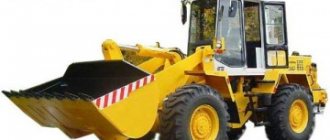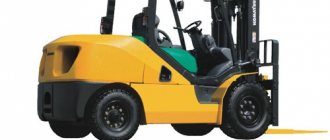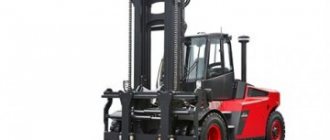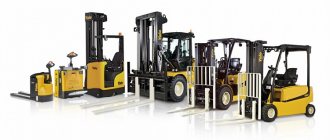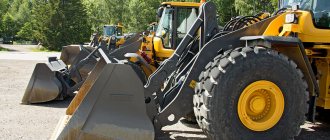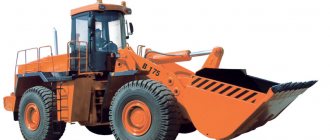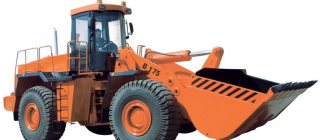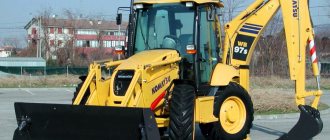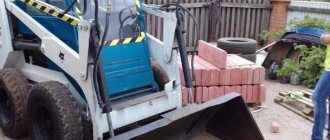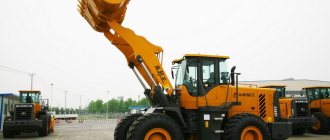Small forklifts are indispensable in warehouses. Today there are ten largest manufacturers of such equipment on the world market, including the Japanese company TSM. The products of this brand are widely known in Russia, because they appeared at domestic enterprises back in 1980. In our country, TSM has become the official distributor of forklifts.
Device Features
The loading equipment device includes the following parts and mechanisms:
- AC motor. It consists of a cylindrical stator, which is made of steel sheets. The axes are located on it at an angle, and the poles of the windings go to the terminal. The engine is also equipped with a rotor, ventilation system, and generator.
- Unit control system. This includes the gearbox and electrical equipment.
- Chassis.
- Brake mechanism. It is equipped with a hydraulic booster for better traction.
- A load lifting device is a retractable mast onto which a load is placed for transportation.
- Tires.
- Optional equipment. This could be a snow blower, a special clamp for transporting household appliances, etc.
- Rechargeable batteries that power the entire electrical system of the forklift.
Spare parts
Here you will find spare parts for HYSTER forklifts, original TCM spare parts, spare parts for STILL forklifts, spare parts for CATERPILLAR forklifts and other models of forklifts. In addition, there is a large assortment of filters for forklifts: filters for KALMAR forklifts, filters for JUNGHEINRICH forklifts. The company offers a wide selection of spare parts, consumables and additional equipment from its warehouses in St. Petersburg and branches, both for the most common forklift models in Russia and the Middle East (Balkankar, Daewoo, Mitsubishi, Toyota, Nissan, etc.), as well as and for rarely seen loaders. After a certain period of operation, loading equipment of any company requires technical, routine or major repairs.
FCM spare parts, forklift filters and forklift parts from Japan and Europe. Even if you have the most advanced loader, it will still need spare parts over time. Therefore, if you are looking for spare parts for your forklift, no matter how rare they may be, with our help your search will be successfully completed.
Spare parts
Specifications
TCM loader technical characteristics depend on the selected model and unit specification.
Fork
Technical indicators:
| Maximum load capacity | 3000 kg |
| Power unit model | QD32 |
| Fuel fluid | Diesel |
| Engine displacement | 3.2 l |
| Power | 36 horsepower |
| 2150 rpm | |
| 18.5 km/h | |
| Center of gravity of the load being lifted | 0.5 m |
| Mast length | 2.25 m |
| Fork lift height | 3m |
| Wheels | Pneumatic |
| Wheel formula | 2*2 |
| 2.4 m | |
| 114 mm | |
| Piston stroke | 130 mm |
| Transmission | Mechanical |
| Number of gears | 4 |
| Dimensions | 2,77*1,23*2,15 |
| Ground clearance | 300 mm |
| Wheelbase | 2450 mm |
| Parking brake type | Manual, disk |
| Fuel tank volume | 150 l |
| Weight | 4365 kg |
The TSM FD30T3Z forklift is used for lifting, transporting and storing cargo, pallets, pallets, etc.
Frontal
Technical parameters of front-end construction loader:
| Maximum lifting weight | 5000 kg |
| Engine model | V3300 |
| Fuel | Diesel |
| Number of cylinders | 4 |
| Power | 47.8 horsepower |
| Nominal crankshaft rotation | 2500 rpm |
| Maximum torque | 1800 rpm |
| Diameter of cylindrical elements | 0.98 cm |
| Piston stroke | 11 cm |
| Maximum travel speed without load | 12 km/h |
| Wheelbase of the unit | 0.93 m |
| Battery capacity | 12 V |
| Service brake mechanism | Disc, wet type |
| Locker on the service brake pedal | Eat |
| Unloading height | 2.2 m |
| Tire size | 10-16.5-6PR |
| Options | 31.6*15.4*2.04 m |
| Climbability | 30° |
| Overall radius | 2.3 m |
| Rear wheel track | 1.25 m |
| Working body capacity | 0.35 m3 |
| Cutting edge width | 1.67 m |
| Front wheel track | 1.25 m |
Bucket
Technical indicators of bucket equipment:
| Lifting weight | Up to 2,500 kg |
| Engine | V2 709-M |
| Fuel fluid | Diesel |
| Power | 33 horsepower |
| Number of cylindrical elements | 4 |
| Rotation frequency | 2400 rpm |
| Working body | Ladle |
| Bucket capacity | 0.35 m3 |
| Diameter of cylindrical parts | 0.87 cm |
| Piston stroke | 7.09 cm |
| Wheelbase | 0.93 m |
| Battery | 12 V |
| Brake type | Disk |
| Front wheel track | 1.25 m |
| Rear wheel track | 1.25 m |
| Climbability | 30° |
| Dimensions | 3.09*1.53*1.94 m |
| Cutting edge width | 1.67 m |
| Turning radius | 2.3 m |
| Tire size | 10-16.5-6PR |
The equipment is equipped with an engine with a liquid-type cooling system, which prevents overheating of all parts of the mechanism. To start the unit in the cold season, the design provides a pre-start heater.
Mini
Technical characteristics of the TCM mini loader:
| Load capacity level | 1750 kg |
| Power unit model | V3300 |
| Fuel fluid | Diesel |
| Power | 47.8 horsepower |
| Engine speed | 2500 rpm |
| Maximum movement speed | 10 km/h |
| Cargo unloading height | 2.4 m |
| Tires | 12-16.5-6PR |
| Battery | 12 V |
| Wheels | Pneumatic |
| Wheel formula | 2*2 |
| External turning radius | 2.4 m |
| Torque | 1800 rpm |
| Diameter of cylindrical elements | 0.98 cm |
| Piston stroke | 11 cm |
| Climbability | 30° |
| Number of cylinders | 4 |
| Dimensions | 3,33*1,68*1,96 |
| Ground clearance | 0.3 m |
| Wheelbase | 1.04 m |
| Parking brake type | Disk |
| Fuel tank volume | 100 l |
| Width of the cutting edge of the working body | 1.75 m |
- You cannot transport goods that are poorly assembled.
- You cannot stop or move jerkily.
TCM forklift repair and causes of malfunctions:
- Transmission malfunction can be caused by low pressure in the system, dirty oil filters, or a faulty safety valve. It is necessary to adjust the pressure, clean the filters, and replace worn parts.
- Loss of power may be due to low oil temperature or low oil level, or air entering the system. It is necessary to change the oil and remove air.
- If there are problems with the clutch, you should inspect the mechanism for damage and repair it.
We repair equipment only using special equipment and wearing protective clothing: goggles or a mask.
TSM is a Japanese company specializing exclusively in the production of various loaders with wide functionality. They have the capabilities to load, clean and unload a variety of small and large bulk materials and goods, as well as carry, lift and stack intermodal merchandise items.
The TCM company, which created the first Japanese loader in history, currently includes 6 enterprises with 4 of them located in Japan, one in China and another in the USA (South Carolina). Its products are known all over the world and are very popular among thrifty business executives and entrepreneurs who give preference to reliability and quality: despite being relatively cheap, these machines are in some ways even superior to their branded counterparts.
The range of TSM devices includes loaders and stackers of a wide range of capacities, designed to work with loads weighing up to 30 tons. Model lines of special equipment from TSM, numbering about 170 modifications, can be divided into 3 main groups based on drive type:
- Up to 3.5 tons - multifunctional units, the “lightest” of which can lift loads to a height of up to 7 meters;
INTERESTING! Gasoline loaders from TSM have the ability to combine gasoline and gas fuels due to their equipment with gas cylinder equipment (gasoline machines). This allows you to minimize CO (carbon monoxide) emissions and safely operate the devices in enclosed spaces.
And according to the purpose and external features, the classification of TSM loaders is as follows:
- fork;
- frontal;
- bucket;
- universal mini-devices.
Attachments
Attachments can be roughly divided into three categories, depending on the capabilities that they provide:
The first group includes auxiliary attachments TCM , for example, a device for side-shifting the carriage (side-shift), which allows you to adjust the position of the carriage relative to the forklift and helps shift the load to the side when the forklift is stationary. This group also includes a fork positioner, which reduces the time required to work with different types of pallets and eliminates the need to move the forks manually.
This type of device makes work more convenient and faster, but this equipment does not provide any additional functions.
The second group includes devices that expand the functionality of a forklift: fork extensions, pushers, clamping devices, devices for rotating the carriage, etc.
Fork extensions allow you to easily and quickly change the length of the fork working surface, allowing the forklift to handle loads of different sizes.
The mechanism for turning the carriage allows you to rotate loads, pour liquids from containers, overturn the load or place it in a vertical position. The rotation angle can reach up to 360°.
Fork rotators allow you to change the angle of rotation of the carriage, thereby simplifying the unloading of bulk and liquid cargo.
This group also includes inclined forks, retractable carriages and carriages with variable fork angles, which are designed to simplify the work with large, long or hard-to-reach loads.
Buckets are typically used to handle bulk materials. To use them, it is necessary to equip the loader with a carriage with a variable fork angle.
Various types of cargo grippers allow you to work with different types of cargo, store and transport several of them at a time. In addition to specialized grips, there are universal types of grips that allow you to work with both regular cargo and bales, bales and boxes.
Attachments that provide the loader with new functionality are expensive, but the costs are offset by the increased productivity of the loader or the ability to more compactly place loads in warehouse areas.
Installation of built-in attachments requires the installation of additional hydraulic valve sections. Their number is determined by the number of hydraulic functions of the attachment.
In order to select the right attachments, it is necessary to take into account the dimensions and type of cargo, as well as its storage conditions, which will directly affect the manipulations performed with it. In addition, you need to take into account the size of the passages along which the forklift will move.
When operating a loader equipped with attachments, do not forget that the operations that the loader must perform become more complicated, so the operator operating such a loader must be highly qualified.
The lifting and transport equipment market offers a wide selection of attachments from both world-famous manufacturers (KAUP, Cascade), as well as attachments produced by loader manufacturers, for example, TCM.
To ensure that attachments can be installed on different brands of loaders, companies produce equipment with a standard carriage, which can have different sizes in accordance with the load capacity of the loader.
Thus, the attachments provide versatility, ease of installation and increased operational efficiency.
Attachments
Forklifts
TSM forklifts are used for lifting, moving and stacking various loads weighing up to 10 tons.
Photo of TSM forklift
Peculiarities
Popular models of forklifts from TCM make up the “INOMA” series. These machines use two-pronged forks as working equipment, suitable for lifting and stacking. INOMA “fork holders” are distinguished by their simplicity of design, ease of maintenance and long-term trouble-free operation, achieved thanks to the following characteristic elements:
- Powerful engines with volumes of up to 6.5 liters, allowing you to reach maximum speed with a load in just 4.3 seconds;
- Anti-corrosion protection of the car roof with tube moisture drains;
- High-speed ascent with a speed of at least 390 mm/s;
- Automatic transmission;
- Electronic control;
- Single motor braking function;
- Operator comfort (improved visibility, ergonomics of the cabin interior, noise reduction);
- Safety of actions - on top of the machine there is a safety grill built into the roof.
ATTENTION! When working on TCM, you should be careful with the headlights: they are not protected from mechanical damage, while the rear lights are completely protected by the roof pillars.
In addition to the simple “INOMA”, the company can also offer a series of forklifts of the original modern design Acroba. They are equipped with a 4-wheel steering system, are very maneuverable and are complemented by other cutting-edge technologies.
Specifications
Technical characteristics of popular models in the table:
Video review of the TSM forklift:
TSM forklifts
TCM Corporation, which created the first Japanese forklift, is one of the world's leading manufacturers of warehouse equipment. TCM forklifts are manufactured in Japan at factories certified in accordance with the requirements of ISO 9001 and ISO 14001. High quality assembly of gasoline and diesel forklifts, forklifts, electric forklifts, universal forklifts (skid loaders), reliability and adaptation to Russian conditions allow TCM forklifts to be operated in any production modes .
The INOMA series of forklifts, supplied to Russia since 2005, received the prestigious GOOD DESING AWARD 2005, which is awarded to products with excellent technical characteristics and high performance.
Models of loaders with diesel and gasoline engines and attachments for them. TSM forklifts (diesel and gasoline forklifts) from 1.5 to 10 tons occupy leading positions in sales of forklifts in Russia, and forklifts from 5 to 16 tons are the absolute leaders in sales in Japan (45% of the Japanese market share).
This equipment can be purchased on credit, leasing, or in installments.
TSM forklifts
Front loaders
TSM front-end single-bucket loaders are designed not only for lifting loads, but also for digging and cleaning areas.
Photo of TSM front loader
Peculiarities
The machines have a front-mounted working tool - a volumetric bucket, as well as:
- Adaptability to work in Russian winter conditions.
- Environmentally friendly high power power unit with efficient cooling system.
- High load capacity with relatively fast transport movement.
- Possibility of changing attachments to fulfill any utility, construction and transport needs.
Specifications
The video shows the TSM front loader in operation:
Bucket loaders
TSM bucket-type loaders are designed for lifting, transporting and loading bulk cargo.
Features of this special equipment:
- High power.
- Capacious bucket equipment with convenient design and protection against spillage.
- Ability to work even in limited areas.
- Ease of management and maintenance.
ATTENTION! The TCM series of BOBCAT bucket loaders includes models that do not have a cabin.
Specifications
Mini loaders
This technique is distinguished by two most important parameters - super-increased maneuverability and versatility of use.
Peculiarities
The capabilities of mini loaders from TSM are the result not only of their compact size, but also of their design features:
- Very small turning radius - practically turning on the spot. This is achieved through a hydrostatic transmission equipped with 2 motors and pumps, as well as dry multi-disc brakes.
- The new bucket design is A-shaped with an increased lift angle, which allows all operations to be performed smoothly and minimizes the problem of spillage.
- Hydraulic mechanism for leveling working equipment on lift.
- Quickly change the attachment, which can be used as different types of buckets, as well as forks, grabs, etc.
- Operator safety system with hydraulic system blocking.
IMPORTANT! Small-sized TCM loaders can move freely even on uncomfortable and slippery surfaces.
Photo of mini loader TSM SSL 709
Specifications
Video review of TSM SSL series mini loaders:
Standard equipment and auxiliary mechanisms:
Equipment
:
- The brake lining material does not contain asbestos.
- Centrifugal air cleaner.
- Regenerative cooling system.
- Cylindrical hood support with safety lock.
- Seat with improved suspension and seat belt.
- Hitch.
- Engine with preheating system (diesel).
- Fuel system sump (diesel).
- Steering with hydraulic booster.
- Transistor ignition FTI (petrol engine).
- Reinforced top guard.
- Mast with increased visibility.
- Dipstick for monitoring the hydraulic oil level.
- Chassis class 3 and 4 ITA.
- Long-life J-lug tires.
- Lift circuit shut-off valve.
- Cargo support wall.
- Load control valve.
- Top air intake system.
- Power brake.
- Hydraulic clutch with hydraulic booster (manual gear shift).
- Retaining rollers.
- Return hydraulic filter.
- Filter on the suction pipe of the hydraulic system.
- Tilt stop valve.
- Transmission oil level dipstick (power shift).
- Transmission oil filter (power shift).
- Fork 1070 mm (1220 mm for 5 tons).
- 2-spool control valve with pressure relief mechanism.
- 3-way catalytic muffler (gasoline engine), made in the USA.
Controls:
- Electric gear shift lever (power shift).
- Lift and tilt levers.
- Multifunctional switch (lighting and direction indicators) with automatic reset mechanism.
- Parking brake lever with lock.
- Tilt steering column.
- Handle for easy entry into the forklift.
- Reverse alarm buzzer.
- Reversing lights.
- Improved floor mat with anti-slip coating.
- Document clip.
- Document holder.
- Electrical sound signaling device.
- Front combination lights (direction indicators, clearance lights).
- Glove box/pen holder.
- Headlights.
- High-mounted rear combination lights (tail markers, brake light, reverse light, turn signals and reflector).
- Driver's Tool Kit.
- Top safety fence awning.
- Side view mirrors.
- Tilt cylinder covers.
Devices and switches:
- Air cleaner clogging indicator.
- Charging indicator.
- Check engine light (for gasoline engines), made in the USA.
- Engine oil pressure indicator.
- Fuel indicator.
- Fuel system sump indicator.
- Glow plug indicator (diesel).
- Operating hours counter.
- Engine ignition switch-off system (diesel).
- Neutral safety switch.
- Water temperature indicator.
Additional cargo accessories:
- Forks of various lengths.
- Bale grabber.
- Cardboard gripper (on request).
- Crane console (on request).
- Barrel grip (on request).
- Forks (on request).
- Fork extensions. Fork installation device (hydraulic type).
- Fork installation device (manual type).
- High and wide load support wall.
- Articulated forks, bucket.
- Load pusher (on request).
- Load stabilizer (on request).
- Ram.
- Rotating bale grabber.
- Rotating forks (mounted, built-in type).
- Rotary paper roll gripper (mounted, built-in type).
- Lateral displacement device.
- Hook with sleeve (on request).
- Extended fork carriage. 2-stage wide view mast (VFM). 3-stage wide view mast (VFHM).
Additional equipment and auxiliary mechanisms:
Equipment:
- Air conditioner (steel cabin).
- Auxiliary hydraulic valve modules.
- Centralized lubrication system.
- Colored tires (white, green).
- Exhaust system with filter (diesel).
- Air cleaner with double element.
- Engine air pre-cleaner.
- Muffler with catalyst for exhaust gas purification.
- Front driving dual wheels.
- Heater.
- Heater and defrost (steel cabin).
- High top safety guard (2400 mm).
- Hydraulic oil cooler (diesel).
- Low top safety guard (2130 mm).
- Device for operation on liquefied gas or combined fuel (gasoline engine).
- Overhead exhaust system.
- Radiator with plate fins.
- Dustproof mesh for radiator (small and medium mesh).
- Semi-integrated power steering.
- Muffler with smoke filter and spark arrester (diesel).
- Solid tires (special soft tires).
- Steel cabin.
- Windshield with wiper.
- 4-cylinder mast.
Auxiliary equipment:
- Coloring as agreed with the customer.
- Fire extinguisher.
- Rear work lights.
- Rotating warning light (beacon).
- Rotary hydraulic cylinder cover.
- Tilt hydraulic cylinder cover.
Devices and switches:
- Ammeter.
- Control monitor (fuel level, battery electrolyte level, coolant level, parking brake, air cleaner).
- Speedometer.
- Torque converter hydraulic oil pressure gauge.
- Torque converter hydraulic oil temperature gauge (power shift).
Small forklifts are indispensable in warehouses. Today there are ten largest manufacturers of such equipment on the world market, including the Japanese company TSM. The products of this brand are widely known in Russia, because they appeared at domestic enterprises back in 1980. In our country, TSM has become the official distributor of forklifts.
Features of the range
TCM technology is synonymous with reliability and high performance. The first models rolled off the assembly line in 1949, and today the range of equipment for warehouses includes electric, gasoline and diesel TSM forklifts, as well as stackers of various capacities for stacking cargo on racks. The company's product range also includes additional attachments to expand the capabilities of the main equipment.
Still, the backbone is forklifts. Today there are 170 models, which are conditionally included in three groups:
- Diesel engines
, which are especially popular on the Russian market. These are machines with a carrying capacity from 3.5 to 43 tons. Regardless of power, this technique is capable of lifting loads to a height of up to 7 meters. “Giants” of this category can be supplemented with grippers of different widths, with the help of which they lift rolls, barrels, bales, and bags. Diesel cars are valued for their high-torque performance, efficiency and ease of maintenance. This technique has found wide application not only in small warehouses, but also in port facilities and railway stations. TCM diesel vehicles are marked FD. - Gasoline
, the carrying capacity of which is 1.5-3.5 tons. They are used both in closed warehouses and in open areas. Compared to diesel ones, the engine of such loaders is designed for a longer service life. The latest models are equipped with additional gas equipment, due to which it was possible to reduce fuel costs and minimize carbon monoxide emissions. Gasoline cars are marked with the letters FG. - Electric
with a lifting capacity of 1-3.5 tons. This equipment is characterized by a high level of environmental friendliness, so it is suitable for use in enclosed spaces. Despite their low power, the machines can handle lifting loads to a height of up to 6.8 meters. The advantage of TCM developments using an electric motor is operation without recharging for 8.5 hours. To reduce energy consumption, the machines are equipped with a multifunction display, which displays information about the operation of the system. TCM marks this line with the letters FB.
Japanese brand equipment can be classified according to its main purpose and appearance:
- forklifts;
- frontal;
- bucket;
- universal machines.
The Japanese company TCM Corporation, specializing in the production of lifting equipment and transportation equipment, was founded in 1949. It was then that a forklift rolled off the assembly line appeared on the industrial markets of Japan. Toyo Carrier Manufacturing - this is what the abbreviation TCM stands for.
TSM is a famous Japanese brand owned by the company, under which modern forklifts are produced that have proven themselves well in the market. TCM Corporation, founded in 1949, can safely be called a true innovator in the field of production of lifting equipment.
The company's outstanding achievements are the first Japanese forklift (1949) and the first Japanese front-end loader (1960), as well as the unique Acroba forklift - its feature is the presence of all steerable wheels.
Ryugasaki Plant, Ibaraki Prefecture, Japan and Chokoji-cho Plant, Shiga Prefecture, Japan.
The main production of TCM is located in Japan and includes two factories НZНS and Shiga. It produces port equipment, as well as forklifts and universal loaders. The corporation also has factories in the USA, Sweden, Spain and China.
In 2013, TCM Corporation and Nissan Forklift Ltd became part of UniCarriers Corporation.
TCM forklifts
The durability of TCM loaders is evidenced by the fact that on the secondary market you can still find “running” machines from the 70s. The price of all models is quite adequate to their technical level. Thus, in Japan, TCM and Toyota loaders cost approximately the same, which indicates the high quality of TCM products. Only Toyota 7 Series models are more expensive, primarily due to the large number of electronic components, which sometimes overly complicate the design, increasing the cost of operating and maintaining the machine.
Almost all components and components - gearboxes, automatic transmissions, load lifters and frames, drive and steering axles - are manufactured and assembled by TCM Corporation independently. At the same time, like most Japanese manufacturers, TCM equips its loaders with powerful Japanese-made engines - Isuzu or Kubota.
Service support for TCM equipment requires almost no special equipment. At the same time, like any other equipment, these loaders require careful attention: you need to fill in the oil that is recommended, and it is better to use good diesel fuel, from those gas stations where it meets the required level of quality.
As for climatic conditions, these loaders work successfully both on the northern Japanese islands, in the mountains, where there is snow for four months of the year, and in the hot south, where palm trees grow. So the loaders are designed taking into account any operating conditions, which is very important for the Russian consumer.
I would also like to note this. Our consumers are accustomed to diesel forklifts, but in addition to these machines, TCM produces models with gas (they are more environmentally friendly) and gasoline engines. Of course, we have some problems with gas filling stations, but gasoline models are $800-$1500 cheaper than diesel ones and can be more economical to operate.
Summarizing what has been said, I would like to emphasize once again that the main advantages of (standard) TCM loaders are reliability, survivability, ease of operation and maintenance.
TCM loaders stand out on the market primarily due to their unprecedented reliability and durability. It is quite possible to find working machines produced in the 80s and 90s.
TCM chronology
1949 — The founding of Toyo Carriers Manufacturing Co., Ltd., the root of the TCM brand, was accompanied by the release of the first Japanese-made forklift.
1950 — Export of forklifts to foreign markets begins. The first export truck was sent to Taiwan.
1954 — The company name has changed to Toyo Umpanki Co., Ltd.
1970 — The Shiga plant was established and production activities begin in October.
1983 — A large order for 1000 units of forklifts was received from the Pentagon, USA.
1994 — Anhui TCM Forklift Co., Ltd was founded. (now called UniCarriers China Corporation).
1999 — The company name has been changed to TCM Corporation.
2001 — TCM Asia Distribution Co., Ltd. (now called UniCarriers Asia Co., Ltd.) in Thailand is established as a regional sales office for Southeast Asia.
2007 — A new plant for the production of drive units has been created at the Shiga plant.
2010 — The first forklift was certified as a “Mechanical Heritage” by the Japan Society of Mechanical Engineers in 1949.
2011 — TCM Forklift (M) Sdn. Bhd. (Now called UniCarriers Malaysia Sdn. Bhd.), a joint venture for the sales and service of forklifts in Malaysia.
2012 — TCM Corporation joins the UniCarriers group in August 2012.
2014 — Start of sales of the SMART Machine series.
2017 — The work of Mitsubishi Logisnext begins. Mitsubishi Logisnext becomes a supplier of TCM products.
In our work we build long-term partnerships. Fulfilling your obligations, reliability and reputation are prerequisites for stable cooperation.
The advantage of Japanese-made equipment
TSM machines are valued for their high service life. The manufacturer provides a guarantee for its equipment for up to 5 years or up to 5000 operating hours. One of the advantages of this brand was the elimination of complex electronic components, which made it possible to reduce repair and maintenance costs.
In Russian factories you can most often see diesel models. They are valued for their high performance and speed of raising and lowering the forks. On average power units it is 54 cm/s on the rise with a load and 55 cm/s without a load. Regardless of the model, the cars are equipped with a two-speed automatic transmission, and modes are switched with just one touch of the accelerator pedal. The same transmission is installed on gas-gasoline loaders.
Despite the massive abandonment of diesel among leading automakers, TCM is confident in the safety of its engines and claims to comply with Tier 2 emissions requirements. This was achieved by updating the pre-chamber ignition system. In addition to reducing gas emissions, it provides additional power and speed to the loader itself.
Heavy-duty machines used in harsh conditions provide good performance thanks to the robust differential and frame-mounted axles.
TCM loaders (all models) are equipment designed with the operator in mind. They have a fundamentally new mast: the expanded distance between the lifting chains made it possible to increase visibility of the frontal area by 10%. An ergonomic seat with suspension and tilt functions was added for the operator. Its high sides and back guarantee safety when working on slopes. The driver's protection system is a belt with an automatic unlocking function in a critical situation.
Warranty service
Maintenance, equipment care, troubleshooting, defect prediction, repair of forklifts are the main tasks of the company’s service department.
Advantages of repairing forklifts with us:
- Contract Maintenance extends the warranty period on new forklifts and electric forklifts from 1 year or 2000 m/h to 5 years or 5000 m/h, whichever comes first.
- Guarantee against errors in determining the need for spare parts and operating materials for the loader. The required range of spare parts for only one type of forklifts with a lifting capacity of up to 3.5 tons ranges from 900 to 1,500 items.
- Our prices for service and repair of forklifts are the best on the market. We offer a flexible system of discounts.
- Possibility of carrying out complex routine repairs and major repairs of forklifts in the service center. Assistance in delivering faulty machines to the Service Center.
- Before any repairs begin, the client is informed of the scope of work, the cost of repairs and spare parts for the forklift. No work, including additional work, is performed without the client’s consent. Complete openness and coordination of actions with the client is one of the main principles of the service.
Practice confirms that high-quality service of a forklift is an indispensable condition for its long-term trouble-free operation.
Warranty service
Seventh series of INOMA loaders
In 2005, fundamentally new TSM loaders of the INOMA generation entered the market. No new forms were added to them; on the contrary, the models turned out to be very simple. The update affected performance. The technical characteristics of the seventh generation TCM loaders have made them leaders. By updating the engines, the manufacturer managed to reduce the time spent on loading and unloading operations. The advantages of the TSM brand described above reveal the features of the seventh generation of Japanese technology.
The INOMA series has been known in Russia since 2005, but over the 14 years of its successful existence it has undergone changes:
- reduced the weight of the instrument unit and weight distribution, thereby increasing the level of stability and stabilization;
- changed the engine cooling system and hydraulic system;
- optimized visibility of the upper zone, which simplified the operator’s work and increased the level of safety in using forklifts in enterprises;
- added two freewheel cylinders instead of one, which in the Acroba series was located in the center of the mast.
TSM Corporation in the Russian forklift market
TCM Corporation, founded more than half a century ago, is a pioneer in the development of material handling equipment: back in 1949, it produced the first forklift in Japan, and 11 years later - a front-end loader. Since then and to this day, the production of special equipment has been the leading activity of TSM, while most other Japanese companies are mainly engaged in the creation of passenger cars, and consider the production of loading equipment to be a side activity. Historically, the company has concentrated its efforts primarily on developing the domestic market, where in a number of segments, in particular the production of heavy forklifts, it has firmly taken a leading position and has a large number of corporate clients.
| FB 15-7 |
Thanks to its high reliability, ease of operation and maintenance, TCM loading equipment quickly became widely known not only at home, but also in Europe, where German manufacturers traditionally occupy leading positions in this area. In recent years, TCM has confidently ranked among the top ten world leaders in terms of production and sales of forklifts. (See the article “Year 2003: summing up the first results”, “SiT”, No. 10, 2004)
Today, the TSM brand is considered synonymous with quality and reliability throughout the world. The high level of technology allows the company to produce very efficient and at the same time structurally simple equipment that is not overloaded with electronic components. The leading place in the corporation's program, as before, is occupied by forklifts - 31.9% of total turnover: every year 12-15 thousand new machines roll off the assembly lines of its Japanese enterprises alone. In addition to stacking equipment, the company has three more production sectors: construction machinery (14.6%); newly developed products and systems, including equipment for processing universal containers (19.1%); production of spare parts, customer service, leasing and rental (34.4%).
Hoisting and transport machines and systems of more than ten types are subject to annual modernization at the company's enterprises, and priority areas for product improvement are determined based on consumer requests.
| TCM enterprises in Ryugasaki (Ibaraki Prefecture) |
In Japan, forklifts with a capacity of 1...10 tons are produced at a plant located in Shiga Prefecture; heavier models (lifting capacity 10...42 t), front loaders, cranes, mining equipment and original equipment are manufactured at the plant in Ryugasaki. In addition to these plants, the company owns production facilities in the USA and Belgium. TCM products are sold by 23 distributors in Japan (out of a total of more than 100 sales branches) and its worldwide sales network is supported by 68 partners. At the end of the reporting year 2003/2004, the company's annual total sales amounted to 588 million euros, of which 286 million euros worth of floor-standing vehicles were sold.
Currently, TCM offers a full range of standard sizes of forklifts with an internal combustion engine (ICE) and electric drive, consisting of six main series. The main distinguishing feature of their design is simplicity, which has a positive effect on both the reliability and the cost of operating the equipment. The standard range of TCM vehicles with internal combustion engines includes:
• 1…3-ton models (FG/D 10-30; FG – with petrol and gas engines, D – with diesel engines);
| TSM enterprises in the prefecture Whitefish |
• the latest loaders with a capacity of 3.5...5.0 tons with improved technical and operational characteristics (FG/D 35-50)2;
• loaders with a capacity of 6...10 t (FD 60-100), equipped with a low-emission engine equipped with an exhaust gas purification system. Models in this series have an exceptionally high fork lifting speed: for the FD60 model it reaches 510 mm/s (with load);
• loaders with a capacity of 16…23 t (FD160/180; FD200/230);
• models FD370 and FD420 (37 and 42 t capacity) with high-power internal combustion engines, suitable for transporting products of large engineering and metallurgical enterprises, universal (sea) 20- and 40-foot containers and other heavy cargo.
TCM, like most Japanese manufacturers, equips its loaders with powerful and reliable Nissan, Isuzu or Kubota engines.
| FD 15 |
The line of electric forklifts (FB series) with increased lift height includes 14 models. These machines combine high performance and efficiency. High maneuverability makes them especially convenient for use in cramped conditions, in particular in heavily loaded warehouses. The models have the following advantages:
• the longest continuous operation time among machines in its class, which is achieved through a significant reduction in energy consumption (30%);
• particularly precise regulation of the battery charging process (this is the first such system introduced in this industry);
• fully automated (microcomputer controlled) charger;
• operator's seat shock absorber, providing protection from harmful influences (vibration reduction by 65%, noise reduction by 20%).
| Acroba |
In addition to standard models, TSM produces unique Acroba forklifts, which have no analogues in the world. The linear range of these machines consists of six models with a capacity of 1.5...4.0 tons with internal combustion engines (produced in 2000) and four models of Acroba-e (with a capacity of 1.5...3.0 tons, 2001. ) with electric drive. The diesel model uses four innovations that were first used in this sector of mechanical engineering: the ability to move transversely; zero turning radius; operator's seat rotatable by 45°, which simplifies and increases safety of work; hydrostatic drive HST with a 2x2 wheel arrangement, which significantly increased the grip of the wheels on the road surface. The features of Acroba-e electric forklifts include, first of all, the presence of three power modes (for loading and unloading, transportation and idling), which allows saving up to 30% of consumed electricity.
In addition to standard equipment, TSM loader models are equipped with two- and three-stage lift racks (VFM and VFHM), additional attachments - a wide carriage, swivel forks, paper grip, etc., double front wheels and a wide fender, massive or colored tires and other options. Almost all components and components - gearbox, automatic transmission, load lifter and frame, drive and steering axles - are manufactured and assembled at the company's factories. Models are developed taking into account any operating conditions, which is very important for the Russian consumer.
In 1992, TCM received the Product Safety and Reliability Award for a forklift that operated for 6,500 hours without failure, and in 1997–1998, the corporation's production was certified in accordance with ISO 9001 quality and ISO 14001 environmental standards. In total, the company received seven awards for best solutions in the field of material handling equipment design - more than any other company in the field of construction equipment production.
TCM supplies equipment in Russia. It was founded in 1993 and monthly sells hundreds of units of trucks and special equipment - MAZs, ZILs, KamAZs, tractors from Russian and Belarusian manufacturers and special equipment based on them. After a comprehensive study of the Japanese loading equipment market, at the beginning of 2002, the company signed an agreement with TSM, becoming the first official representative of a Japanese corporation in Russia. The equipment has proven itself so well on the Russian market and has received so many positive reviews that now “Velikan-Rustractor” is engaged in the supply, maintenance and repair of forklifts and front-end loaders only of the TSM brand.
The publication was prepared by
V. Antonov
Forklift Models
Three-ton trucks are popular in warehouses. Among diesel models, the TOP includes FD30T3Z and FD35T3S. From gas-gasoline – FG30T3C. With an electric motor, FB30-8 is in demand.
FD30T3Z
Diesel explosion-proof forklift with a cargo capacity of 3 tons. The lifting height is up to 3 meters, so this model is suitable for work in small warehouses. The delivery equipment includes standard forks. A crane boom, a fork with a pantograph, and a disk trencher are suitable as attachments for this model.
Specifications:
- dimensions (LxWxH, mm): 2705x1225x2090;
- fork length (mm): 1070/1200;
- corridor width (mm): 4150/4280;
- speed forward/backward (km/h): 18.5/19;
- lifting speed under load/without load (mm/s): 450/460;
- ground clearance (cm): 14.5;
- slope (%/°): 18/10.2.
FD35T3S
This model is used for transporting palletized goods over short distances. It has a load capacity of 3500 kg, while the lifting height is only 3 meters. The FD35T3S differs from the FD30T3Z only in power. Despite its increased dimensions, this machine can only be used in rooms with a level surface, since even small unevenness can cause destabilization.
Specifications:
- dimensions (LxWxH, mm): 2800x1290x2140;
- fork length (mm): 1070x150x50;
- corridor width (mm): 4235;
- speed forward/backward (km/h): 19/19.5;
- lifting speed under load/without load (mm/s): 460/490;
- ground clearance (cm): 12.5;
- slope (%): 18.
FG30T3C
Loader with a gas-gasoline engine with a lifting capacity of up to 3 tons. Despite its compact size, it lifts loads to a height of up to 7 meters. It comes with standard forks designed for transporting containers (pallets). Additionally, you can install a briquette grabber. Unlike popular diesel models, this gasoline “baby” shows excellent fork lifting and lowering speeds. One of its disadvantages is its low ground clearance, which complicates the operation of the loader on construction sites. But when it comes to overcoming slopes, it is difficult for him to compete.
Specifications:
- dimensions (LxWxH, mm): 2245x1070x2070;
- fork length (mm): 920;
- corridor width (mm): 3495;
- speed forward/backward (km/h): 19/19;
- lifting speed under load/without load (mm/s): 620/660;
- ground clearance (cm): 10.5;
- slope (%): 31.
FB30-8
Not the most powerful electric forklift among Japanese equipment, but it is the one that can most often be found in warehouses. It is designed for a maximum weight of 3 tons, while its lifting height is still the same 3 meters. Judging by the dimensions, the power of this model could have been greater if not for the electric motor. In addition to the standard forks, a roll gripper and a cardboard gripper are available. Of all the TCM electric forklifts, this model is considered the most compact and productive, which is why it is successfully used in tight spaces, for example, when working in the hold of a ship.
Specifications:
- dimensions (LxWxH, mm): 2510x1225x2075;
- fork length (mm): 1070;
- corridor width when storing pallets 110*110 (mm): 3705;
- speed with/without load (km/h): 14/15;
- lifting speed under load/without load (mm/s): 290/490;
- ground clearance (cm): 9;
- slope (%): 6.
Frontal
This equipment is used not only for loading and unloading operations, but also for clearing roads. Front loaders from TSM work with quick-release equipment. The design of the chassis and transmission made it possible to adapt the equipment to Russian conditions. These are machines with increased maneuverability and increased traction force, which allows them to be used on soils with a low coefficient of adhesion.
the SSL-709 mini skid steer front loader.
. Its layout is classic: a double-beam boom and a hydrostatic transmission with chain wheel drive. The bucket lift design follows a radial pattern. At the end of the boom there is a mechanism for quickly changing attachments, which makes this model compatible with Bobcat.
Specifications:
- bucket volume (m3): 0.35;
- load capacity (kg): 690;
- forward/backward speed (km/h): 12;
- traction force (kN): 24.5;
- rear turning radius (mm): 1380;
- machine length with bucket (mm): 3090;
TSM mini loaders
Universal SSL mini loaders are designed to work with replaceable attachments.
Exceptional maneuverability and high travel speed are achieved due to the special design of the transmission and chassis; the front loader also provides high traction on soils with a low coefficient of adhesion.
The SSL diesel bucket loader combines compact dimensions and high functionality. The load capacity of the SSL loader varies from 400 to 840 kg. The SSL loader with quick-release attachments (brush, blade, rotary snow blower, forks, hydraulic hammer, etc.) is indispensable in public utilities and when performing construction and landscaping work.
SSL mini loaders occupy 55% of the total Japanese market in this class.
| Manufacturer | TSM | ||
| Model | SSL707 | SSL709 | SSL711 |
| Bucket volume, m3 | 0,31 | 0,35 | 0.31 |
| Nominal load capacity, kg | 580 | 690 | 840 |
| Tipping load, kg | 1260 | 1400 | 1680 |
| Travel speed forward/backward, km/h | 12,0 | 12,0 | 10.0 |
| Maximum traction force, kN | 22,5 | 24,5 | 29.4 |
| Minimum turning radius, rear, mm | 1380 | 1380 | 1420 |
| Width of loader with bucket, mm | 1540 | 1670 | 1750 |
| Wheelbase, mm | 930 | 930 | 1040 |
| Track forward/backward, mm | 1250/1250 | 1250/1250 | — |
| Total height of the protective cabin, mm | 1940 | 1940 | 1995 |
| Loader length with bucket, mm | 3090 | 3090 | 3330 |
| Maximum unloading height, mm | 2200 | 2200 | 2400 |
| Ground clearance, mm | 185 | 185 | |
| Total weight, kg | 2480 | 2720 | 3340 |
| Engine, manufacturer | KUBOTA | KUBOTA | KUBOTA |
| Model | V2403-M | V2403-M | V3300 |
| Volume, l | 2,434 | 2,434 | 3.318 |
| Rated power, kW/rpm | 33,5/2400 | 33,5/2400 | 47.8/2500 |
TSM mini loaders
